 |
 Up
Up
|
|

|

|
A slide rule with a Wow! |
|
|
|
|
|
|
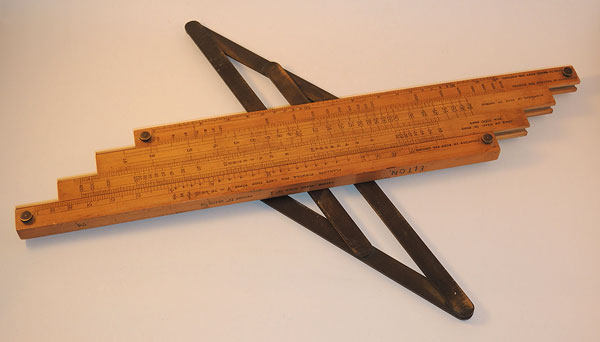 Click photo to enlarge |
|
|
|
A lucky win I won this rule at the auction of Tom Wyman’s
collection. |
|
|
|
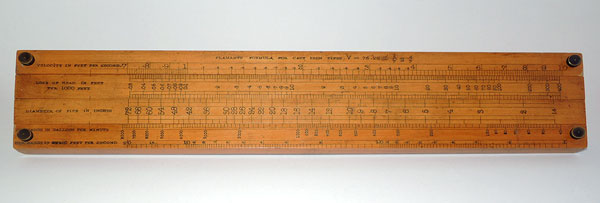 Click photo to enlarge |
|
|
|
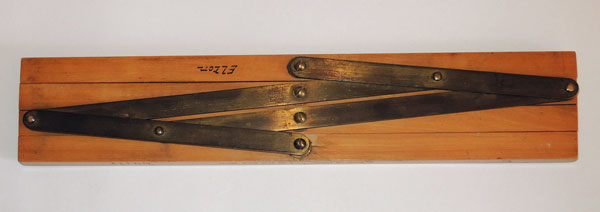 Click photo to enlarge |
|
|
|
An amazing contraption The most adequate word to convey one’s first
encounter with the Baines slide rule is “Wow!” (or, perhaps,
“Whoa!!”). This is not exclaimed when you first see it in its folded
state; then it seems like a nice old boxwood rule, at once solid and
stolid. And then you pull on the little brass knobs at opposite
corners of the rule, and – Whoa! – out pops a complicated pantograph
structure of articulated metal rods that were hidden on the rule’s
back side, and the four wooden scales spring into motion and extend
this way and that. Wow!!... |
|
|
|

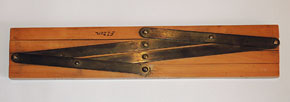 |
|
|
|
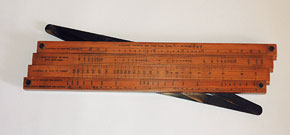
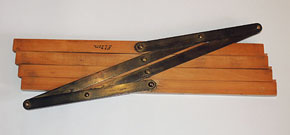 |
|
|
|
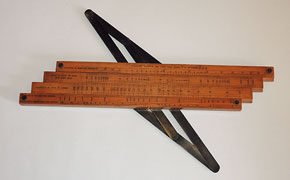
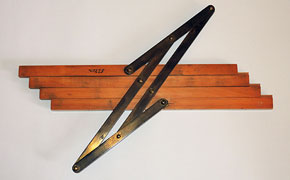 |
|
|
|
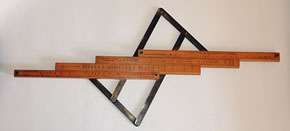
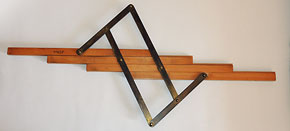 Click a photo to enlarge |
|
|
|
In case you wonder how far the rule can extend itself, the answer is, VERY far: here it is pulled out all the way. |
|
|
|

 Click a photo to enlarge |
|
|
|
And of course, it can do the same trick in the other direction as well: |
|
|
|
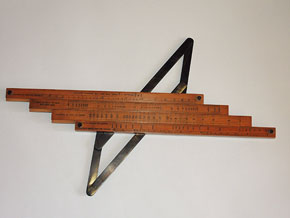
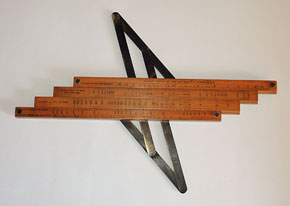 Click a photo to enlarge |
|
|
|
This rule implements the principle of forcing a dependent motion of the slides. It has no stator, or stock – the fixed part that the slide usually move in. Instead, it has four identically sized slides that all move relative to each other – under the constraints imposed by the pantograph in the back. |
|
|
|
You can see in the photo to the right how the four slides are kept sliding next to each other, using a variant of a sliding dovetail joint. |
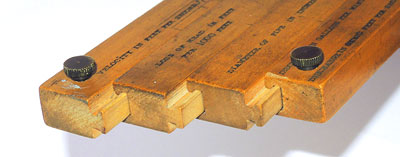 Click photo to enlarge |
|
|
|
A look at the edge of the rule tells us that it is the Baines slide rule No. 1, awarded the British patent number 25109/03 – the 03 stands for the year 1903. We also see the scratched imprint of one Elton, presumably the device’s owner, who also put his name on the back of one of the slides; and a number, 74, whose meaning is unclear. |
|
|
|
 Click photo to enlarge |
|
|
|
What it does
The purpose of this unusual device is to do
calculations involving the flow of water in iron pipes. This class
of problems is complicated by friction in the water at the inner
surface of the pipe, which causes a “head loss”. “Head” here means
water pressure, and is expressed in length units – it is defined as
the height of a column of water that would exert that pressure at
its base. Thus, the energy loss to friction causes the pressure to
drop, and the head loss measures this drop per length of pipe – in
this slide rule it is specified in feet (of head) lost per 1000 feet
(of pipe length). The formula used, as shown on the rule, is V=76.28*d5/7*S4/7 , where
These parameters are represented in the top three scales on the slide rule; a fourth parameter, shown on the last scale, is
While the Flamant formula does not include the
discharge Q, the slide rule does calculate it from the velocity V
and cross-sectional area A of the pipe: Q=A*V , Usage example So – here is an example of a real calculation: |
|
|
|
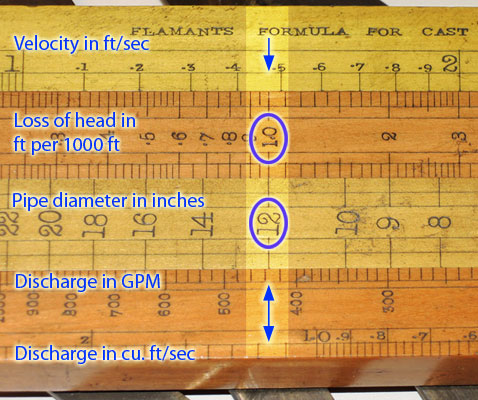 |
|
|
|
The nice thing is that once you align two
parameters vertically, the other two truly “present themselves”: you
don’t have to hunt them down elsewhere on the rule, they are right
there on the same vertical line.Who was Mr. Baines?The patent listed on the edge of the rule is accessible online, and from it we learn that this device was invented by Hewley Mortimer Baines. Further research informed me that Mr. Baines graduated in 1888 from the Royal Indian Engineering College. This college, located in Surrey, England, trained civil engineers for service in the Indian Public Works Department, and Baines had indeed shipped to India and spent two decades in the Punjab Public Works Department before retiring in 1910. Although the patent mentions the suitability of the idea to problems other than water flow, I find no reference anywhere to a similar device used for such a problem; perhaps Mr. Baines was happy to rest on his laurels after giving us the Slide Rule No. 1. |
|
|
|
Exhibit provenance: I purchased this slide rule at the Oughtred Society’s auction of items from the Tom Wyman collection. I am indebted to the late Colin Barnes for much useful information about this device and its inventor; and to Stefan Heimann for guiding me through the relevant intricacies of hydrological science and nomenclature. More info: You can see Baines's patent, from 1903, here. See also “Baines and his Slide Rule”, by Colin Barnes and John Bolton, UKSRC Gazette, Issue 9 – Autumn 2008, p. 8. This article also reproduces an article in The Engineer, April 1, 1904. E. M. Horsburgh, Modern instruments and methods of calculation: a handbook of the Napier tercentenary exhibition (London : G. Bell and Sons, Ltd. ; The Royal Society of Edinburgh, 1914), has some of the math in page 162. |
|
|
|
|
|
|
|
Home | HOC | Fractals | Miscellany | About | Contact Copyright © 2016 N. Zeldes. All rights reserved. |
|